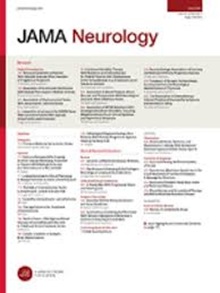Gene Therapy vs Cochlear Implantation in Restoring Hearing Function and Speech Perception for Individuals With Congenital Deafness.
IF 21.3
1区 医学
Q1 CLINICAL NEUROLOGY
引用次数: 0
Abstract
Importance OTOF gene therapy (GT) has been shown to improve hearing and speech. The efficacy of GT remains to be compared against cochlear implantation (CI), the current gold standard for congenital deafness. Objective To evaluate treatment outcomes in auditory and speech perception between patients with congenital deafness treated with GT, CI, or both. Design, Setting, and Participants This nonblind cohort study was conducted between December 2022 and November 2024. GT patients received follow-up at 3, 6, and 12 months; CI patients received 1-time evaluation at the corresponding time intervals or longer (3, 6, or 12 months). The study was conducted at a single class A tertiary hospital in China. Participants with congenital severe to complete hearing loss, aged 1 to 18 years, who received GT or CI were enrolled. They were matched on duration of deafness, hearing thresholds, and speech ability at the presurgical baseline. Of 1568 participants screened, 72 participants enrolled. Participants were excluded if they had inner ear malformations or vestibular-cochlear nerve abnormalities. Exposures GT only vs CI; bimodal (unilateral GT plus contralateral CI) vs bilateral CI; GT (CI turned off [CI-off]) vs unilateral CI. Main Outcomes and Measures The primary outcomes were auditory and speech perception evaluated by questionnaires, including the Infant-Toddler Meaningful Auditory Integration Scale/Meaningful Auditory Integration Scale (IT-MAIS/MAIS), and tests, including audiometry, speech, and music tests. The main secondary outcome was auditory information processing ability assessed by mismatch negativity (MMN). Results A total of 11 GT patients (6 male [55%]; mean [SD] age at baseline, 3.7 [2.8] years) and 61 CI patients (34 male [56%]; mean [SD] age at baseline, 1.9 [1.5] years) were enrolled. The mean (SD) auditory brainstem response thresholds were restored from greater than 95.0 (0.0) decibels normalized hearing level (dB nHL) to 54.8 (15.9) dB nHL in 9 GT patients at 12 months. For GT-only vs CI in auditory and speech perception, GT patients performed better in IT-MAIS/MAIS at 6 months (median [IQR] score, 31.0 [30.0-32.0] vs 23.5 [19.0-26.3]; P = .01) and 12 months (median [IQR] score, 32.0 [31.0-32.0] vs 28.0 [24.5-30.5]; P = .007). GT patients showed shorter latencies of MMN at 6 months (median [IQR], 0.20 [0.05-0.21] seconds vs 0.23 [0.22-0.25] seconds; P = .006). For bimodal patients at 12 months, GT (CI-off) patients performed better than unilateral CI patients in speech in a noisy environment (median [IQR] disyllable, -1.0 [-3.0 to 2.4] dB sound pressure level (SPL) vs 5.3 [3.1 to 12.1] dB SPL; P = .03); GT plus CI patients performed better than bilateral CI patients in singing in-tune rates (median [IQR], 66.6% [53.7%-83.9%] vs 37.1% [30.3%-56.3%]; P = .04); GT plus CI patients showed shorter latencies of MMN at 12 months (median [IQR], 0.08 [0.07-0.10] seconds vs 0.21 [0.15-0.23] seconds, P = .01). Conclusions and Relevance GT patients showed stable hearing recovery and exhibited more rapid improvements in auditory and speech performance than CI patients, while outperforming CI patients in speech in noise performance and music perception. These findings suggest that GT may provide a novel effective treatment alternative for patients with genetically driven congenital deafness.基因治疗与人工耳蜗植入恢复先天性耳聋患者的听力功能和语言感知。
tof基因治疗(GT)已被证明可以改善听力和语言。GT的疗效仍有待与目前先天性耳聋的金标准人工耳蜗植入(CI)进行比较。目的评价先天性耳聋患者接受GT、CI或两者同时治疗的听觉和言语感知效果。设计、环境和参与者这项非盲队列研究于2022年12月至2024年11月进行。GT患者分别在3、6和12个月接受随访;CI患者在相应的时间间隔或更长时间(3,6或12个月)接受1次评估。本研究是在中国一家三甲医院进行的。1 - 18岁的先天性重度至完全性听力损失患者接受GT或CI治疗。他们在耳聋持续时间、听力阈值和手术前基线的语言能力方面进行了匹配。在筛选的1568名参与者中,有72名参与者入组。如果参与者有内耳畸形或前庭-耳蜗神经异常,则被排除在外。仅暴露与CI;双峰(单侧GT +对侧CI) vs双侧CI;GT (CI关闭[CI关闭])vs单侧CI。主要结果和测量方法主要结果是听觉和语言感知,通过问卷评估,包括婴儿-幼儿有意义听觉整合量表/有意义听觉整合量表(IT-MAIS/MAIS)和测试,包括听力、语言和音乐测试。以失配负性(MMN)评价听觉信息加工能力。结果GT患者共11例,其中男性6例[55%];平均[SD]基线年龄3.7[2.8]岁)和61例CI患者(34例男性[56%];基线时平均年龄(SD)为1.9[1.5]岁。9例GT患者12个月时的平均(SD)听觉脑干反应阈值从大于95.0(0.0)分贝标准化听力水平(dB nHL)恢复到54.8 (15.9)dB nHL。在听觉和言语感知方面,GT患者在6个月时的IT-MAIS/MAIS表现更好(IQR评分中位数分别为31.0[30.0-32.0]和23.5 [19.0-26.3];P = 0.01)和12个月(中位[IQR]评分,32.0 [31.0-32.0]vs 28.0 [24.5-30.5];p = .007)。GT患者在6个月时MMN潜伏期较短(中位[IQR], 0.20[0.05-0.21]秒vs 0.23[0.22-0.25]秒;p = .006)。对于12个月时的双峰患者,GT (CI-关闭)患者在嘈杂环境中的言语表现优于单侧CI患者(中位数[IQR]双音节,-1.0[-3.0至2.4]dB声压级(SPL) vs 5.3[3.1至12.1]dB SPL;p = .03);GT + CI患者比双侧CI患者在唱腔合调率方面表现更好(中位数[IQR], 66.6% [53.7%-83.9%] vs 37.1% [30.3%-56.3%];p = .04);GT + CI患者在12个月时MMN潜伏期较短(中位[IQR], 0.08[0.07-0.10]秒vs 0.21[0.15-0.23]秒,P = 0.01)。结论与相关性egt患者的听力恢复稳定,听觉和语言表现的改善比CI患者更快,而语音表现在噪音表现和音乐感知方面优于CI患者。这些发现提示GT可能为遗传性先天性耳聋患者提供一种新的有效治疗选择。
本文章由计算机程序翻译,如有差异,请以英文原文为准。
求助全文
约1分钟内获得全文
求助全文
来源期刊

JAMA neurology
CLINICAL NEUROLOGY-
CiteScore
41.90
自引率
1.70%
发文量
250
期刊介绍:
JAMA Neurology is an international peer-reviewed journal for physicians caring for people with neurologic disorders and those interested in the structure and function of the normal and diseased nervous system. The Archives of Neurology & Psychiatry began publication in 1919 and, in 1959, became 2 separate journals: Archives of Neurology and Archives of General Psychiatry. In 2013, their names changed to JAMA Neurology and JAMA Psychiatry, respectively. JAMA Neurology is a member of the JAMA Network, a consortium of peer-reviewed, general medical and specialty publications.
 求助内容:
求助内容: 应助结果提醒方式:
应助结果提醒方式:


